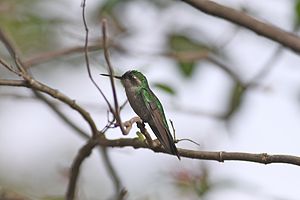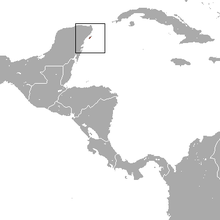Emerald Swallowtail Hummingbird
| Emerald Swallowtail Hummingbird | ||||||||||
|---|---|---|---|---|---|---|---|---|---|---|

Emerald Swallowtail Hummingbird ♀ |
||||||||||
| Systematics | ||||||||||
|
||||||||||
| Scientific name | ||||||||||
| Chlorostilbon forficatus | ||||||||||
| Ridgway , 1885 |
The swallowtail emerald hummingbird ( Chlorostilbon forficatus ) is a species of bird in the hummingbird family (Trochilidae) that is endemic to the islands of Cozumel and Isla Mujeres off the Yucatán peninsula . The IUCN assesses the population as Least Concern . The species is considered to be monotypical .
features
The swallowtail emerald hummingbird reaches a body length of about 8 to 9.5 cm. The straight beak is about as long as the head or a little longer. The adult male has a long, strongly forked tail. The head and body are emerald green, the top and bottom are glittering green. The tail is blue-black with the exception of the brownish gray tips of the inner tail feathers . The adult female also has a forked tail. The white eye stripe contrasts with the green top of the head and the blackish ear covers. The neck and top are green, the underside light gray. The deep blue-green inner tail feathers and the outer blackish tail feathers have white tips on the outermost three pairs. The base of the outer flags is white on the two outermost pairs.
Behavior and nutrition
The swallowtail emerald hummingbird gets its nectar from dry forests and their edges. It also feeds on insects. It gets its food from plants from all over the island, including city gardens, jungles and mangroves.
Vocalizations
The song of the swallowtail emerald hummingbird is described with dry rattling and cackling tones. These are similar to other species in the genus Chlorostilbon .
Reproduction
Nothing is known about the breeding biology of the swallowtail emerald hummingbird. It is believed that the breeding behavior is similar to that of the blue-tailed emerald hummingbird .
distribution and habitat
The swallowtail emerald hummingbird prefers bushy forests, scrub and secondary vegetation .
Etymology and history of research
The first description of the swallowtail emerald hummingbird was in 1885 by Robert Ridgway under the scientific name Chlorostilbon forficatus . The type specimen came from Cozumel and was collected on January 23, 1885 by James Everard Benedict (1854-1940), Tarleton Hoffman Bean (1846-1916) and Thomas Lee (1858-1936). In 1853 John Gould introduced the new genus Chlorostilbon . "Chlorostilbon" is made up of the Greek words "chlōros χλωρός " for "green" and "stilbōn στίλβων " for "shining". The Greeks gave Mercury the nickname Stilbōn, which is due to the verb "stilb" for "blink". The species name "forficatus" is a Latin word formation from "forfex, forficis" for "scissors" and "facere" for "to make".
literature
- Josep del Hoyo , Nigel James Collar , Guy Maxwell Kirwan , Peter Boesman in: Josep del Hoyo, Andrew Elliott, Jordi Sargatal , David Andrew Christie , Eduardo de Juana: Cozumel Emerald (Chlorostilbon forficatus) In: Handbook of the Birds of the World Alive . Lynx Edicions, Barcelona.
- James A. Jobling: Helm Dictionary of Scientific Bird Names . Christopher Helm, London 2010, ISBN 978-1-4081-2501-4 .
- Robert Ridgway: Description of some new species of birds from Cozumel Island, Yucatan . In: Proceedings of the Biological Society of Washington . tape 3 , 1885, p. 21-24 ( biodiversitylibrary.org ).
- John Gould: A monograph of the Trochilidæ, or family of humming-birds . tape 5 , delivery 5. Taylor and Francis, London 1853 ( biodiversitylibrary.org ).
- Frederick Herschel Waterhouse: The dates of publication of some of the zoological works of the late John Gould, FRS RH Porter, London 1885 ( biodiversitylibrary.org ).
- María Coro Arizmendi, Humberto Berlanga García, Claudia Rodriguez-Flores, Víctor Manuel Vargas-Canales, Leobardo Montes Leyva, Rafael Lira Saade: Hummingbird Conservation in Mexico: The Natural Protected Areas System . In: Natural Areas Journal . tape 36 , no. 4 , 2016, p. 366-376 ( pdfs.semanticscholar.org ).
- Cozumel Birding Club: Common and unique birds of Cozumel Island . CONAMP, Cancun 2017 ( issuu.com ).
Web links
- Chlorostilbon forficatus inthe IUCN Red List of Endangered Species 2019.1. Listed by: BirdLife International, 2016. Accessed July 23, 2019.
- BirdLife International: Species Factsheet - Cozumel Emerald ( Chlorostilbon forficatus ) . Retrieved July 23, 2019.
- Videos, photos and sound recordings of Cozumel Emerald (Chlorostilbon forficatus) in the Internet Bird Collection
- Emerald Swallowtail Hummingbird ( Chlorostilbon forficatus ) at Avibase; accessed on July 23, 2019.
- Chlorostilbon forficatus in the Integrated Taxonomic Information System (ITIS). Retrieved July 23, 2019.
- xeno-canto: Sound recordings - Swallowtail emerald hummingbird ( Chlorostilbon forficatus )
- Cozumel Emerald (Chlorostilbon forficatus) in the Encyclopedia of Life . Retrieved July 23, 2019.
